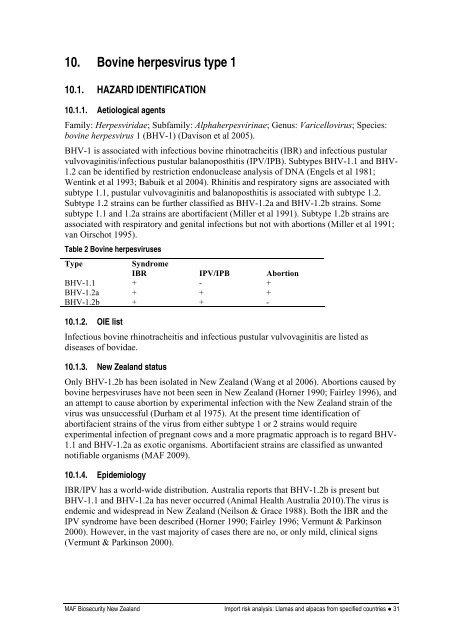Import risk analysis: Llamas (Lama glama) and alpacas (Vicugna ...
Import risk analysis: Llamas (Lama glama) and alpacas (Vicugna ...
Import risk analysis: Llamas (Lama glama) and alpacas (Vicugna ...
Create successful ePaper yourself
Turn your PDF publications into a flip-book with our unique Google optimized e-Paper software.
10. Bovine herpesvirus type 1<br />
10.1. HAZARD IDENTIFICATION<br />
10.1.1. Aetiological agents<br />
Family: Herpesviridae; Subfamily: Alphaherpesvirinae; Genus: Varicellovirus; Species:<br />
bovine herpesvirus 1 (BHV-1) (Davison et al 2005).<br />
BHV-1 is associated with infectious bovine rhinotracheitis (IBR) <strong>and</strong> infectious pustular<br />
vulvovaginitis/infectious pustular balanoposthitis (IPV/IPB). Subtypes BHV-1.1 <strong>and</strong> BHV-<br />
1.2 can be identified by restriction endonuclease <strong>analysis</strong> of DNA (Engels et al 1981;<br />
Wentink et al 1993; Babuik et al 2004). Rhinitis <strong>and</strong> respiratory signs are associated with<br />
subtype 1.1, pustular vulvovaginitis <strong>and</strong> balanoposthitis is associated with subtype 1.2.<br />
Subtype 1.2 strains can be further classified as BHV-1.2a <strong>and</strong> BHV-1.2b strains. Some<br />
subtype 1.1 <strong>and</strong> 1.2a strains are abortifacient (Miller et al 1991). Subtype 1.2b strains are<br />
associated with respiratory <strong>and</strong> genital infections but not with abortions (Miller et al 1991;<br />
van Oirschot 1995).<br />
Table 2 Bovine herpesviruses<br />
Type<br />
Syndrome<br />
IBR IPV/IPB Abortion<br />
BHV-1.1 + - +<br />
BHV-1.2a + + +<br />
BHV-1.2b + + -<br />
10.1.2. OIE list<br />
Infectious bovine rhinotracheitis <strong>and</strong> infectious pustular vulvovaginitis are listed as<br />
diseases of bovidae.<br />
10.1.3. New Zeal<strong>and</strong> status<br />
Only BHV-1.2b has been isolated in New Zeal<strong>and</strong> (Wang et al 2006). Abortions caused by<br />
bovine herpesviruses have not been seen in New Zeal<strong>and</strong> (Horner 1990; Fairley 1996), <strong>and</strong><br />
an attempt to cause abortion by experimental infection with the New Zeal<strong>and</strong> strain of the<br />
virus was unsuccessful (Durham et al 1975). At the present time identification of<br />
abortifacient strains of the virus from either subtype 1 or 2 strains would require<br />
experimental infection of pregnant cows <strong>and</strong> a more pragmatic approach is to regard BHV-<br />
1.1 <strong>and</strong> BHV-1.2a as exotic organisms. Abortifacient strains are classified as unwanted<br />
notifiable organisms (MAF 2009).<br />
10.1.4. Epidemiology<br />
IBR/IPV has a world-wide distribution. Australia reports that BHV-1.2b is present but<br />
BHV-1.1 <strong>and</strong> BHV-1.2a has never occurred (Animal Health Australia 2010).The virus is<br />
endemic <strong>and</strong> widespread in New Zeal<strong>and</strong> (Neilson & Grace 1988). Both the IBR <strong>and</strong> the<br />
IPV syndrome have been described (Horner 1990; Fairley 1996; Vermunt & Parkinson<br />
2000). However, in the vast majority of cases there are no, or only mild, clinical signs<br />
(Vermunt & Parkinson 2000).<br />
MAF Biosecurity New Zeal<strong>and</strong> <strong>Import</strong> <strong>risk</strong> <strong>analysis</strong>: <strong>Llamas</strong> <strong>and</strong> <strong>alpacas</strong> from specified countries ● 31

















